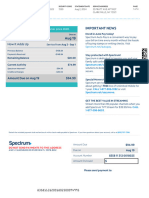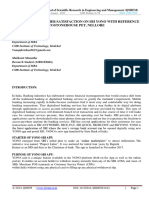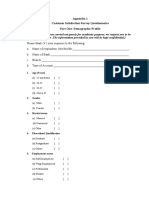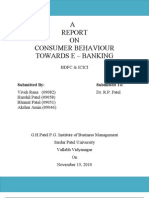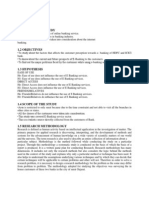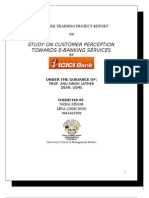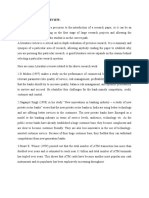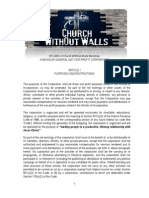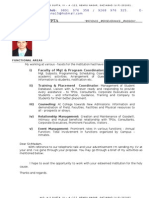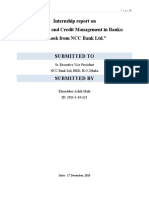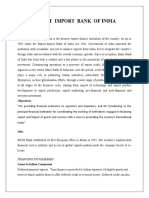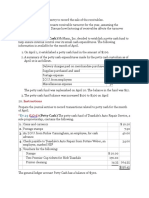Review of Literature
Review of Literature
Uploaded by
jamarnath05Copyright:
Available Formats
Review of Literature
Review of Literature
Uploaded by
jamarnath05Original Description:
Copyright
Available Formats
Share this document
Did you find this document useful?
Is this content inappropriate?
Copyright:
Available Formats
Review of Literature
Review of Literature
Uploaded by
jamarnath05Copyright:
Available Formats
REVIEW OF LITERATURE 1.) Customer Definition: SOURCE: Grigoroudis, E & Siskos, Y (2009).
. Customer Satisfaction Evaluation: Methods for Measuring and Implementing Service Quality. Springer.
WITH REFERENCE TO LOYALTY: A customer is the person that assesses the quality of the offered products and services WITH REFERENCE TO PROCESS ORIENTED APPROACH: The customer is the person or group that receives the work output 2.) CUSTOMER SATISFACTION Definition
SOURCE: Westbrook and Reilly (1983), The Vicious Circle of Consumer Complaints, Journal of Marketing, Vol.48, (Summer). ABSTRACT: According to Westbrook and Reilly (1983) , customer satisfaction is an emotional response to the experiences provided by, associated with particular products or services purchased, retail outlets, or even molar patterns of behavior such as shopping and buyer behavior, as well as the overall market place
SOURCE: Berry, L.L. and Parasuraman, A. (1991), Marketing Services: Competing through Quality. The Free Press, New York, NY ABSTRACT: Berry and Parasuraman (1991) argue that since customers satisfaction is influenced by the availability of customer services, the provision of quality customer service become a major concern of all businesses. has
SOURCE: Schiffman, L.G. and Kanuk, L.L. (2004), Consumer Behaviour. Prentice Hall, Upper Saddle River, NJ. ABSTRACT: Schiffman and Kanuk (2004) defines customer satisfaction as The individuals perception of the performance of the product or service in relation to his or her expectations.
SOURCE: www.wikipedia.org/wiki/Customer_satisfaction ABSTRACT: Customer satisfaction, a business term, is a measure of how products and services supplied by a company meet or surpass customer expectation
SOURCE: Oliver (1977). Satisfaction: A Behavioral Perspective on the Consumer. Boston: McGraw-Hill. Cited in Willard Hom (2000), An Overview of Customer Satisfaction Models, RP Group Proceedings, California Community Colleges. ABSTRACT: Oliver (1977) defines Satisfaction is the consumers fulfillment response. It is a judgment that a product or service feature, or the product of service itself, provided (or is providing) a pleasurable level of consumption- related fulfillment, including levels of under- or over-fulfillment.
3.) Studies Conducted in Abroad: 1. SOURCE: What keeps the e-banking customer loyal? a multigroup analysis of the moderating role of consumer characteristics on e-loyalty in the financial service industry, Journal of Electronic Commerce Research, Vol 7, No.2, 2006. ABSTRACT: Arne Floh Horst Treiblmaier1 investigated the importance of antecedents of online loyalty such as trust, quality of the Web site, quality of the service and overall satisfaction. Rather than investigating which factors drive customers to use online banking instead of offline banking, his study addresses the problem of how to keep customers online and loyal to a specific supplier. A survey among more than 2,000 customers of an Austrian online bank was conducted and a structural equation modeling approach was used to gain important insights into how customer retention in the online banking business can be ensured. Satisfaction and trust were identified as important antecedents of loyalty. Additionally, the moderating role of consumer characteristics (gender, age, involvement, perceived risk and technophobia) was supported by the data.
2. SOURCE: Bankers' Perspectives on Internet Banking, e-Service Journal 1.1, Fall 2001 ABSTRACT Nath, Ravi and Schrick Paul,4 examined bankers' views on providing banking services to customers using the web in Unites States. Specifically, it addresses issues such as the strategic need for Internet banking, its effect on customer-bank relationships, and customers' experiences in Internet banking. Data collected from 75 banks show that most banks do not yet offer full-fledged Internet banking. However, most have plans to do so. Furthermore, bankers see Internet banking as a strategic opportunity that can reduce transaction costs, enhance customer service, increase the customer base and improve cross-selling opportunities. Also, Internet banking is perceived more favorably by banks that offer it compared to those that do not.
3. SOURCE: E-banking and customer preferences in Malaysia: An empirical investigation, Information Sciences Vol.150, Issues 3-4, pages 207-217, 2003. ABSTRACT: M. Sadiq Sohail and Balachandran Shanmugham,6 examined the current trends in the e-commerce revolution that has set in motion in the Malaysian banking sector and reports on an empirical research that was carried out in Malaysia to study the customers preference for electronic banking and the factors, which they considered influenced the adoption of electronic banking. Results based on the analysis of data relating to 300 respondents indicate that while there is no significant differences between the age and educational qualifications of the electronic and conventional banking users, some
differences exists on other demographic variables. Analysis further revealed that accessibility of Internet, awareness of e-banking, and customers reluctance to change are the factors that significantly affected the usage of e-banking in Malaysia.
4. SOURCE: Predictors of Intention To Continue Using Internet Banking Services: An Empirical Study of Current Users, International Journal of Business and Information, Volume 3, Number 2, December 2008. ABSTRACT: Huam Hon Tat and Khalil Md Nor,8 their study investigates predictors of intention among current users to continue using the services. Questionnaires were distributed to 210 residents in Klang Valley, Malaysia, of whom 204 (97.1%) responded to the survey. The findings demonstrated that, among the predictors tested, trust was found to be the
strongest predictor of intention to continue using Internet banking, followed by compatibility and ease of use. Recommendations to Internet banking service providers and discussions for future study are provided.
5. SOURCE: The Impact Of Internet Banking Service Quality On Satisfaction And Behavioral Intentions, International Journal of Business and Information, Volume 3, Number 2, December 2008. ABSTRACT Lim Yik Ming, in his study he developed and empirically tested a conceptual model of the impact of internet banking service quality on customer satisfaction and behavioral intention. Based on the relevant literature review, a questionnaire was designed and administered to 300 users of internet banking in Mauritius. The findings revealed that customers' perceptions are consistently lower than their expectations and the most dissatisfied dimension was reliability. It was further found that reliability and security was perceived as the most important dimensions in internet banking transactions that influences satisfaction and behavioral intentions. Customer satisfaction was found to mediate the relationship between customer behavioral intentions.
6. SOURCE: Schiffman, L.G. and Kanuk, L.L. (2004), Consumer Behaviour. Prentice Hall, Upper Saddle River, NJ. ABSTRACT: Schiffman and Kanuk (2004) defines customer satisfaction as The individuals perception of the performance of the product or service in relation to his or her expectations.
7. SOURCE: Woodruff, R.B. & Gardial,S. (1996), Know Your Customer: New Approaches to Understanding Customer Value and Satisfaction. Wiley: Blackwell. ABSTRACT: Woodruff and Gardian (1996) 18define Satisfaction, then, is the evaluation or feeling that results from the disconfirmation process. It is not the comparison itself (i.e., the disconfirmation process), but it is the customers response to the comparison. Satisfaction has an emotional component.
8. SOURCE: Hunt, H. (1977). CS/D: Bits and Pieces in R. Day (Ed), Consumer Satisfaction/Dissatisfaction and Complaining Behaviour. Proceedings of the 2nd Annual Consumer Satisfaction ABSTRACT: According to Hung (1977), . satisfaction is a kind of stepping away from an experience and evaluating it One could have a pleasurable experience that caused dissatisfaction because even though it was pleasurable, it wasnt as pleasurable as it was supposed to be. So satisfaction / dissatisfaction isnt an emotion, its the evaluation of the emotion.
4.) Studies Conducted in India: 1. SOURCE: Service Quality, Customer Satisfaction And Customer Loyalty: A Study With Special Reference To Indian Banking Industries, Indian Journal Of Marketing, Vol.40, No.5, 2010. ABSTRACT: Satendra Thakur examined the effect of service quality and customer satisfaction on customer loyalty among the group of customers in Indian banking industries. Data has been collected from 298 customers of the Indian banking industries; this study is cross sectional and descriptive in nature. With the help of the result of the study we can say that customer satisfaction is significantly and positively related with customer loyalty customer satisfaction is also to be found important mediator between service quality and customer loyalty.
2. SOURCE: E-Banking Scenario And Its Impact On Customers Satisfaction In India, International Journal Of Research In Commerce & Management, Volume No: 2 (2011), Issue No. 4 (April) ABSTRACT: Prof. (DR.) Sultan Singh examined the progress of e-banking scenario concerned with ATMs, Internet banking, Mobile banking and Credit cards and their impact on customers satisfaction by analyzing the problems faced by the customers in India. The analysis shows that among all the e-banking products, Customer Satisfaction Level (CSL) of ATMs is highest and the number of users of ATMs is also highest as compared to other services. Internet banking and credit cards are at second and third position as far as CSL is concerned, but the number of users is more in case of credit cards as compared to Internet banking. Mobile banking is at the lowest position in terms of CSL and also in number of users.
3. SOURCE: A Study on Customer Satisfaction in Indian Retail Banking, Journal of Management Research, vol.12, ABSTRACT: Anubhav Anand Mishra postulates on the present levels of customer satisfaction, and also tries to explore the factors that lead to customer satisfaction in retail banking in India. Data from 100 survey respondents were collected from one branch of one of the prominent retail banks in the city of Hyderabad. The findings revealed that customer satisfaction, a transaction-specific attribute is dependent on seven factors, which concur with extensive academic literature. issue 9, 2009
4. SOURCE: Evaluation gap of internet banking service quality by using servqual approach an empirical study of Indian banks, Journal of Information Management Volume : 47, Issue : 5, 2010 ABSTRACT: Daneshvar Poolad, his study deals with the concept of service quality and has demonstrated the model of service quality gaps; it aims to measure customers gap between satisfaction levels of interpretation of services and their preferences of the interpretive service in internet banking at Indian commercial banks. The research questions are utilized to measure the gap between expectation and satisfaction levels of customers about quality of internet banking. For this purpose a questionnaire with fivepoint Likert scale is applied to measure customers expectation as well as satisfaction. Data was obtained from 102 respondents and analyzed using SPSS 12 software by employing factor analysis and multiple regressions. Results indicate that there are significant differences between overall expectations and satisfaction levels of customers. For practitioners, it is worth noting that customers are exclusively concerned with the Sufficient menu for transaction, Variety of services readily accessible, Availability for business and Have a user-friendly system, as important factors for them to apply internet banking. The study contains material relevant to the internet banking industry, and Implications are discussed and recommendations are offered for improving Internet banking services.
5. SOURCE: Managing Service Quality: An Empirical Study on Internet Banking, Journal of Marketing Management, ABSTRACT: Sunayna Khurana have observed a considerable growth of internet based services. Managing service quality while using internet as a distribution channel is a challenge for the service provider. The main objectives of this research study are to identify the customer preferences towards online banking and to find out the various service quality Volume : 38, Issue :7, 2008
dimensions that affect customer satisfaction in internet banking. Primary data was collected from internet banking users of public and private banks in Hissar district with the help of a structured questionnaire. For the collection of primary data, he confined himself only to the Hissar district. A sample of 100 respondents who actually use internet banking was selected by following non-probabilistic convenience sampling technique as it is appropriate for exploratory studies. Data presentation and analysis were done with the help of various statistical tools using SPSS. Efficiency, responsiveness, fulfillment, privacy of personal information and easiness to use was found to be the core service quality dimensions of internet banking.
6. SOURCE: Internet banking in India: Emerging risks and new dimensions, Business Administration and Management (BAM) Vol. 1(3), pp. 73-81, March 10 ABSTRACT: R. K. Uppal explored the extent of Internet banking in Indian banking industry. Time period taken for study is 2000-01 to 2006-07 because this period is the eye-witness of infant condition of IT and during the same period IT became mature. Simple statistical tools like average, standard deviation, co-efficient of variation are used to calculate the efficiency of various bank groups providing the service of I-banking. On the basis of analysis, the paper concludes that the private sector banks are on the top in providing the I-banking services to their customers and have high profitability as compared to other bank groups under study except foreign banks. The study also highlights the benefits of ibanking to customers as well as to bankers and suggests some strategies with their possible solutions like to spread awareness regarding I-banking and to increase its area and scope to enhance I-banking services in India, particularly in rural and semi-urban areas.
7. SOURCE: Alternative perspectives on service quality and customer satisfaction: the role of BPM, International Journal of Service Industry Management Vol. 19 No. 2, pp. 176-187, 2008 ABSTRACT: Kumar V., investigate the linkages between business process management (BPM) and customer satisfaction. Also, to challenge the dominance of the customer contact perspectives on service processes and to propose a more systemic focus on the totality of service design. The research builds on the existing work of Maddern et al. through the use of structured equation modeling (SEM) tool. The multiple SEM models described here provide a more robust statistical approach for confirming/refuting the constructs found in the earlier research. This study presented the results of an empirical analysis, based on longitudinal data from a large UK bank on drivers of customer satisfaction. The results confirm that process management is a critical driver of technical service quality. This suggested that companies with reliability/dependability issues should not emphasize customer satisfaction programs based on SERVQUAL intangibles until substantial improvements in process design have been achieved.
8. SOURCE: Influence Of Demographic Variables On Customer Satisfaction Regarding E-Banking: An Empirical Investigation, Issues In Information Systems Volume Xii, No. 1, Pp. 436444, 2011 ABSTRACT: S. Kavitha pointed out that today banking industry has undergone a sea change. Bank employees need to provide quality information at the branch at his/her finger tips. It is also necessary that the information should be consistent with all branches and other direct access channels like ATMs. Phone Banking, Mobile banking and Net banking throughout the country. The banking industry should always adapt to the new technology today and basically make the necessary adjustments to gain competitive advantage with other competing banks. E-banking is one such technology and the bank which implement this technology in their organization can definitely survive in this era of intense competition. The main objective of his study is to identify the overall satisfaction of customer regarding the e-banking transactions. The study also aims at knowing whether demographic variables of the respondents have influence on customer satisfaction on Ebanking.
9. SOURCE: Determinants of Customer Satisfaction on Service Quality: A Study of Railway Platforms in India, Journal of Public Transportation, Vol. 13, No. 1, 2010. ABSTRACT: Geetika, Shefali Nandan, in her study, she pointed out that the service quality has been viewed as a determinant of customer satisfaction. Different dimensions of service quality have been considered by various researchers. This study has identified components of service quality of Indian Railways. The study is exploratory in nature and uses factor analysis to identify the most important factors of customer satisfaction with service
quality. The research methodology is empirical, and a survey of passengers was conducted. The finding connect that five factor are considered important to determine
satisfaction with railways, the most important of which are refreshments and behavioral factors. Managerial and theoretical implications were drawn and discussed in the study, and a model was proposed.
10. SOURCE: Online banking in India: An approach to establish CRM, Journal of Financial Services Marketing 15, 176-188 (September 2010) ABSTRACT: Arpita Khare studied the applicability of online banking in India and its role in fostering relationships with customers and giving them more value. The research was conducted on customers familiar with online banking in India, and theirperceptions about online banking were studied. The findings revealed that customers are using the services but are skeptical about the financial transactions and service quality dimensions
Source: http://www.academia.edu/4245425/Analyzing_e-service_quality_in_servicebased_website_by_E-SERVQUAL# E-SERVQUAL Zeithaml et al. (2001, 2002) developed the e-SERVQUAL measure of e-service quality to study how customers judge e-service quality. This new model was drawn up through a three-stage process involving exploratory focus groups and two phases of empirical data collection and analysis. It contains seven dimensions: efficiency, reliability, fulfillment, privacy,
responsiveness, compensation and contact. The first four dimensions are classified as the core service scale, and the latter three dimensions are regarded as a recovery scale, since they are only salient when online customers have questions or problems. Contents of each dimension are shown below: (1) Core service scale in e-SERVQUAL. (a) Efficiency: the capability of customers to access the website, finding their appropriate product and information related to preserving minimum effort. (b) Fulfillment: accuracy of service requirements, availability of the product in storage, and delivering the products on time. (c) Reliability: the technical function of the site, particularly the extent to which it is available and properly functioning. (d) Privacy: assurance that shopping behavior data are not open and that credit card information is secured. (2) Recovery service scale in e-SERVQUAL. (a) Responsiveness: compares the capability of e-retailers to give appropriate data to customers when a problem happens, having mechanisms for handling returns, and giving online guarantees. (b) Compensation: consists receiving money back and returning shipping and handling expenditures. (c) Contact: The requirement of customers to speak to a living customer service agent online or on the phone.
You might also like
- Spectrum BillDocument4 pagesSpectrum Billlogant1222100% (1)
- Regional Rural Banks of India: Evolution, Performance and ManagementFrom EverandRegional Rural Banks of India: Evolution, Performance and ManagementNo ratings yet
- Counselling SupervisionDocument4 pagesCounselling Supervisionjamarnath05100% (1)
- I Owe You Debt Acknowledgment Form PDFDocument1 pageI Owe You Debt Acknowledgment Form PDFAnonymous hNoSDZnXNYNo ratings yet
- A Study On Customer Satisfaction On Sbi Yono With Reference To Stonehouse Pet, Nellore.Document27 pagesA Study On Customer Satisfaction On Sbi Yono With Reference To Stonehouse Pet, Nellore.mohdmujeebahmed01No ratings yet
- A Study On Customer Awareness Towards e Banking.. B. GopichandDocument11 pagesA Study On Customer Awareness Towards e Banking.. B. Gopichandaurorashiva1No ratings yet
- Review of LiteratureDocument4 pagesReview of Literaturemaha lakshmiNo ratings yet
- ProjectDocument50 pagesProjectkomalpreetdhirNo ratings yet
- Customer Perception Towards Internet Banking PDFDocument17 pagesCustomer Perception Towards Internet Banking PDFarpita waruleNo ratings yet
- Quetionnnaire:) Print Media 2 SMS On Mobile 3) Internet 4) OutdoorDocument8 pagesQuetionnnaire:) Print Media 2 SMS On Mobile 3) Internet 4) OutdoorNavpreet SinghNo ratings yet
- Introduction of E CommerceDocument2 pagesIntroduction of E CommerceAkanksha KadamNo ratings yet
- Synopsis of ProjectDocument3 pagesSynopsis of ProjectKomal MansukhaniNo ratings yet
- Mobile Banking SynopsisDocument4 pagesMobile Banking Synopsisujwaljaiswal33% (3)
- Comparative Study of E-Banking Facilities of ICICI and HDFC BankDocument34 pagesComparative Study of E-Banking Facilities of ICICI and HDFC BankRevati santosh salapNo ratings yet
- Customer Satisfaction of ATM Services inDocument11 pagesCustomer Satisfaction of ATM Services inEswari GkNo ratings yet
- Chapter IIDocument13 pagesChapter IIeshu100% (1)
- (3.1) Data Presentation (3.2) Data Analysis (3.3) Data InterpretationDocument37 pages(3.1) Data Presentation (3.2) Data Analysis (3.3) Data Interpretationphuque.awffNo ratings yet
- Roll No. 161 (PROJECT REPORT ON "IMPACT OF E-BANKING ON SERVICE QUALITY OF BANKS")Document96 pagesRoll No. 161 (PROJECT REPORT ON "IMPACT OF E-BANKING ON SERVICE QUALITY OF BANKS")Varun Rodi0% (1)
- Consumer Perception Towards E-Banking Services - 081252-1Document81 pagesConsumer Perception Towards E-Banking Services - 081252-1prathamNo ratings yet
- Black Book ProjectDocument23 pagesBlack Book ProjectAtharv KoyandeNo ratings yet
- Awareness of E-Banking Services Among Rural CustomersDocument10 pagesAwareness of E-Banking Services Among Rural CustomersInternational Journal of Innovative Science and Research TechnologyNo ratings yet
- Final Year Project-Study On Customer Awareness Towards SBI E Banking ServicesDocument28 pagesFinal Year Project-Study On Customer Awareness Towards SBI E Banking ServicesRahul Sah100% (1)
- e Banking ReportDocument40 pagese Banking Reportleeshee351No ratings yet
- Chapter-8 Summary of Findings, Conclusion and SuggestionsDocument28 pagesChapter-8 Summary of Findings, Conclusion and SuggestionsJCMMPROJECTNo ratings yet
- An Analysis of Customer Perception Towards Advance Product Axis and Boi FinalDocument43 pagesAn Analysis of Customer Perception Towards Advance Product Axis and Boi FinalAshis SahooNo ratings yet
- Best Practices 2 Sindhu Durg DCCB PDFDocument13 pagesBest Practices 2 Sindhu Durg DCCB PDFPRALHADNo ratings yet
- E-Banking Services With Special Reference To SBI and ICICI: List of ContentDocument60 pagesE-Banking Services With Special Reference To SBI and ICICI: List of ContentShahebazNo ratings yet
- Project Report On e Banking PDFDocument88 pagesProject Report On e Banking PDFSagarNo ratings yet
- Karan Khanna - B.com Hons - Online BankingDocument81 pagesKaran Khanna - B.com Hons - Online BankingMd SaquibNo ratings yet
- E Banking ServicesDocument90 pagesE Banking ServicesManjunath Leo100% (2)
- AppendixDocument47 pagesAppendixsowmiNo ratings yet
- A Study On Consumer Satisfaction Towards E - Banking" With Special Reference To Syndicate Bank, Vidya Nagara, ShivamoggaDocument55 pagesA Study On Consumer Satisfaction Towards E - Banking" With Special Reference To Syndicate Bank, Vidya Nagara, ShivamoggaShiva KumarNo ratings yet
- Synopsis On Customer Satisfaction On Internet BankingDocument5 pagesSynopsis On Customer Satisfaction On Internet BankingHitesh Chune100% (1)
- Banking ProjectDocument56 pagesBanking ProjectViki Sakpal100% (1)
- Net BankingDocument14 pagesNet BankingVIKASH GARGNo ratings yet
- Customer Perception Towards The Products and Services of HDFC BankDocument54 pagesCustomer Perception Towards The Products and Services of HDFC BankShilpi GhoshNo ratings yet
- Comparison of Sbi Internet Banking Facilities With Icici BankDocument7 pagesComparison of Sbi Internet Banking Facilities With Icici BankEkta KhoslaNo ratings yet
- HDFC NetBanking SynopsisDocument5 pagesHDFC NetBanking SynopsisPranavi Paul Pandey100% (1)
- Questionnaire: Based On Study of Customer Behaviour Towards E-Banking in Private Sector BanksDocument4 pagesQuestionnaire: Based On Study of Customer Behaviour Towards E-Banking in Private Sector BanksAjit Pal Singh HarnalNo ratings yet
- A Comparative Study On Customer Satisfaction Towards Online Banking Services With Reference To Icici and HDFC Bank in LucknowDocument7 pagesA Comparative Study On Customer Satisfaction Towards Online Banking Services With Reference To Icici and HDFC Bank in LucknowChandan Srivastava100% (1)
- Project Mcom PDFDocument45 pagesProject Mcom PDFPriyanka SatamNo ratings yet
- 80 Pages ProjectDocument80 pages80 Pages ProjectR AdenwalaNo ratings yet
- Service Quality Analysis of SBIDocument38 pagesService Quality Analysis of SBIAkhil BhatiaNo ratings yet
- Consumer Behaviour Towards E-Banking - Final ReportDocument68 pagesConsumer Behaviour Towards E-Banking - Final ReportVivek Rana33% (9)
- Need of The StudyDocument3 pagesNeed of The StudyChiragGheenaiyaNo ratings yet
- Jilani Final Report PDFDocument40 pagesJilani Final Report PDFNafeun AlamNo ratings yet
- A Comparative Study On SBI and HDFC in Ambala City Ijariie5997Document11 pagesA Comparative Study On SBI and HDFC in Ambala City Ijariie5997vinayNo ratings yet
- Questionnaire: Services of Private Sector Banks and Public Sector Bank" I AmDocument4 pagesQuestionnaire: Services of Private Sector Banks and Public Sector Bank" I Amaxay12_kimcos10No ratings yet
- Diksha Blackbook Mobile BankingDocument52 pagesDiksha Blackbook Mobile BankingDiksha YNo ratings yet
- Retail Banking Literature ReviewDocument1 pageRetail Banking Literature ReviewAsh Jerk100% (1)
- Comparative Study of The Public Sector Amp Private Sector BankDocument73 pagesComparative Study of The Public Sector Amp Private Sector BanksumanNo ratings yet
- Advance Product of SbiDocument20 pagesAdvance Product of SbiSeKha RudiThongerNo ratings yet
- A Study On Consumer Awareness About E-Banking System - AsDocument73 pagesA Study On Consumer Awareness About E-Banking System - AskomalNo ratings yet
- E Banking QuestionaireDocument28 pagesE Banking Questionaireletter2lalNo ratings yet
- Online Shopping Preference of Youth PDFDocument50 pagesOnline Shopping Preference of Youth PDFSujan pandeyNo ratings yet
- MJ Customer Satisfaction of BSNL ProductsDocument97 pagesMJ Customer Satisfaction of BSNL ProductsMOHIT KASHYAP100% (1)
- A Summer Project Report On Banking and SchemesDocument79 pagesA Summer Project Report On Banking and Schemessimran jeet67% (12)
- Study On Customer Perception Towards E-Banking Services: A Summer Training Project ReportDocument56 pagesStudy On Customer Perception Towards E-Banking Services: A Summer Training Project ReportahenmakkNo ratings yet
- Data Analysis and InterpretationDocument12 pagesData Analysis and InterpretationCharu ModiNo ratings yet
- Literature Review of HDFC BankDocument38 pagesLiterature Review of HDFC BankDevang Malik57% (14)
- CHapter 3 (Literature Review)Document13 pagesCHapter 3 (Literature Review)Kshitij ShingadeNo ratings yet
- Literature Review PRADocument5 pagesLiterature Review PRAkazi mahmudurNo ratings yet
- Preeminent Analysis of Customer Relationship Management (CRM)Document7 pagesPreeminent Analysis of Customer Relationship Management (CRM)jamarnath05No ratings yet
- 15 AppendicesDocument7 pages15 Appendicesjamarnath05No ratings yet
- 10 Chapter 1Document86 pages10 Chapter 1jamarnath05No ratings yet
- Have A Nice Day: Seminor PrasentationDocument28 pagesHave A Nice Day: Seminor Prasentationjamarnath05No ratings yet
- QR Codes in The Library: Are They Worth The Effort? Analysis of A QR Code Pilot ProjectDocument18 pagesQR Codes in The Library: Are They Worth The Effort? Analysis of A QR Code Pilot Projectjamarnath05No ratings yet
- What Today's Charter of Workers' Rights Looks LikeDocument2 pagesWhat Today's Charter of Workers' Rights Looks Likejamarnath05No ratings yet
- Best HR PracticesDocument17 pagesBest HR Practicesjamarnath05No ratings yet
- 12TH Macro Banking Q & ADocument4 pages12TH Macro Banking Q & Akmare4590No ratings yet
- Account Statement 010721 210122Document30 pagesAccount Statement 010721 210122PhanindraNo ratings yet
- Principle of Double Entry & Trial Balance: Prepared By: Nurul Hassanah HamzahDocument35 pagesPrinciple of Double Entry & Trial Balance: Prepared By: Nurul Hassanah HamzahNur Amira NadiaNo ratings yet
- Inner Scorecard Vs Outer ScorecardDocument4 pagesInner Scorecard Vs Outer ScorecardKavish DangNo ratings yet
- Useful InformationDocument13 pagesUseful Informationwotelo5707No ratings yet
- International Liquidity and Reserve ProblemsDocument34 pagesInternational Liquidity and Reserve ProblemsUthama Veeran50% (2)
- Module 4 2Document31 pagesModule 4 2Aeron Carl SabadoNo ratings yet
- General AccountingDocument94 pagesGeneral Accountingswaroopbaskey2100% (2)
- Church WithOut Walls BylawsDocument7 pagesChurch WithOut Walls BylawsAaron BakerNo ratings yet
- List of Cases PFAMRELDocument522 pagesList of Cases PFAMRELMaria Fiona Duran MerquitaNo ratings yet
- Dubai British School Jumeirah Park - School FeesDocument2 pagesDubai British School Jumeirah Park - School FeesfarraheshamNo ratings yet
- Resume 2023-1 - 1678815888675 - Satish Bhaurao BarapatreDocument3 pagesResume 2023-1 - 1678815888675 - Satish Bhaurao BarapatreAniket mishraNo ratings yet
- Kalpana Gupta CVDocument7 pagesKalpana Gupta CVkalpana guptaNo ratings yet
- Finance Vocabulary Fluent UDocument5 pagesFinance Vocabulary Fluent UZiaZuhdyNo ratings yet
- Explain The Scope, Importance, Features, Advantages and Disadvantages of Securitization (Special Purpose Vehicle)Document6 pagesExplain The Scope, Importance, Features, Advantages and Disadvantages of Securitization (Special Purpose Vehicle)somilNo ratings yet
- AGEAS DistributionDocument13 pagesAGEAS Distributionarnab.for.ever9439No ratings yet
- Counter AffidavitDocument3 pagesCounter AffidavitAnonymous XHZQQYSDOqNo ratings yet
- Intern Report of NCC BankDocument90 pagesIntern Report of NCC BankAsik MahiNo ratings yet
- Financial Accounting FoundamentalsDocument5 pagesFinancial Accounting FoundamentalsTimore FrancisNo ratings yet
- Loan Appraisal Process of PNBDocument71 pagesLoan Appraisal Process of PNBNAVPREET SINGHNo ratings yet
- PEOPLE OF THE PHILIPPINES, Plaintiff-Appellee, vs. ROLLY PAGADOR, Accused-AppellantDocument12 pagesPEOPLE OF THE PHILIPPINES, Plaintiff-Appellee, vs. ROLLY PAGADOR, Accused-AppellantelespesyalNo ratings yet
- Islamic Law of ContractDocument24 pagesIslamic Law of ContractAbid RazaNo ratings yet
- Recruitment and Selection Procedure of ExIm Bank LTDDocument79 pagesRecruitment and Selection Procedure of ExIm Bank LTDsagornondiNo ratings yet
- Barclays:Florentina Felicia Barbu: G3578Document10 pagesBarclays:Florentina Felicia Barbu: G3578Barbu Florentina-FeliciaNo ratings yet
- TABL2741 Case NoteDocument7 pagesTABL2741 Case NotenessawhoNo ratings yet
- Export Import Bank of India: Financing ProgrammesDocument4 pagesExport Import Bank of India: Financing ProgrammesLohnnee ThangaveluNo ratings yet
- SST Civics Notes PDFDocument50 pagesSST Civics Notes PDFGirish BhattNo ratings yet
- Tugas Latihan 4Document2 pagesTugas Latihan 4Radit Ramdan NopriantoNo ratings yet
